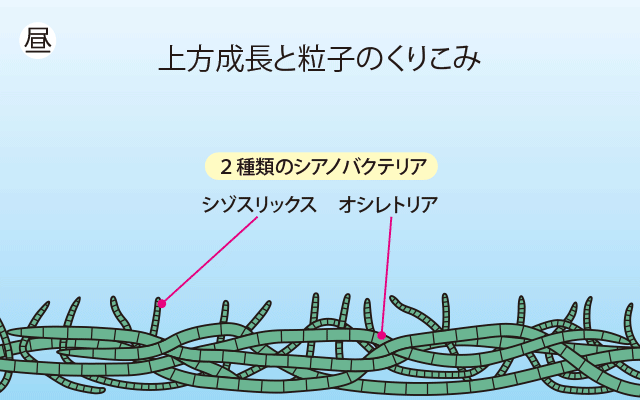ストロマトライトの縞模様(準備中)
Layered structure of stromatolite(Coming soon)

ストロマトライトの発達
Development of stromatolite
大気に含まれる酸素は、多くの生物にとって呼吸によってエネルギーを生み出すために必要な物質である。しかし、地球が誕生してからしばらくの間には、大気の主成分は火山ガスに由来する二酸化炭素であり、酸素はほとんど存在していなかった。大気の酸素濃度を増加させたのは始生代の末に出現したシアノバクテリア(ラン藻類)である。
当時のシアノバクテリアの活動の証拠はストロマトライトと呼ばれる構造物から確認することができる。ストロマトライトとはシアノバクテリアの死骸と泥や砂などの粒が交互に重なり、マッシュルームのような形に発達した岩石のことである(写真と図)。シアノバクテリアが作り出したストロマトライトは始生代の末の約27億年前頃に現れ始め、次の原生代からは非常に多く作られるようになった。
地球表層の酸素はシアノバクテリアの活発な光合成によって25億年ほど前から急激に増加した(大酸化イベントと呼ぶ)。その証拠は約27〜19億年前に形成された縞状鉄鉱床と、約22億年以降に形成された赤色砂岩に見ることができる。縞状鉄鉱床とは縞模様が特徴的な鉄に富んだ鉱床で、海洋で作られたものである。一方の赤色砂岩は砂粒の鉄成分が酸化されて赤色に染まったもので、陸上に堆積したものである。
シアノバクテリアの光合成によって増やされた酸素は、もともと海水の中に豊富にあった鉄と結びついて酸化鉄となり、海底に沈降して縞状鉄鉱床を形成した。しかし、海水の鉄が酸化されつくすと縞状鉄鉱床の形成は終わり、酸素は海から大気へ逃れるようになった。やがて大気中に豊富になった酸素は、今度は陸上の鉄成分を酸化するようになって赤色砂岩が形成されたのである。
ちなみに、現在用いられている鉄資源の大半は、この時期に形成された縞状鉄鉱床から得られたものである。太古の生物からの贈り物によって我々の文明は支えられているのである。
Oxygen contained in the atmosphere is necessary for many creatures to generate energy through respiration. However, for a while after the birth of the earth, atmosphere was mainly composed of volcanic gas derived from carbon dioxide and there was hardly any oxygen. The increase of oxygen began at the end of the Archean eon when Cyanobacteria appeared.
Evidence of Cyanobacterial activity at that time can be confirmed by the study of structure called Stromatolite. A Stromatolite is a mushroom shaped rock (see pic. and fig.) composed of alternating layers of mud/sand and biofilms (microbial mats) of microorganisms (Cyanobacteria). Stromatolite produced by cyanobacterial activity began to appear at the end of the Archean eon (about 2.7 billion YA) and their number exploded during the Proterozoic eon.
Thanks to the cyanobacteria's active photosynthesis called the "great oxygenation event", oxygen on earth rapidly increased bout 2.5 billion years ago. Evidence of such event can be seen by looking at the Banded Iron Formation (BIF) formed between 2.7 and 1.9 billion years ago and the red sandstone formed after 2.2 billion years ago. Banded Iron Formation is an iron-rich deposit characterized by stripe pattern that deposed in the oceans. Red sandstone is a sedimentary rock in which the iron component of the sand oxidized and stained in red. Red sandstone deposited on land.
The oxygen increase made possible by the cyanobacteria's photosynthesis combined with dissolved iron that was originally abundant in seawater precipitated out as iron oxides, which settled on the seabed to form the Banded Iron Formation. When all the iron present into the sea precipitated out as iron oxides, the Banded Iron Formation stopped growing and let the oxygen trapped in the ocean escape into the atmosphere. Eventually, as the atmosphere became richer in oxygen, this one oxidized the iron component on land and gave birth to the red sandstone.
Incidentally, most of the iron resources used are obtained from the Banded Iron Formation formed during this period. Our civilization is build with gifts from ancient organisms.